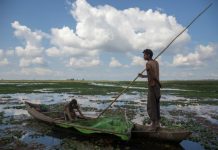For Alakesh, a grade 5 student, 20th March was the last time he visited his school which is situated in rural Majuli. It has now been a total of 135 days without school. On 25th March the whole country abruptly went into total lockdown following in the footsteps of other countries in order to tackle the spreading virus that had begun to take the shape of a pandemic. Everything came to a standstill, and this is now being labelled by many as the ‘new normal’.
Although, over time some rules were relaxed but educational institutions continued to remain closed from the very beginning of the series of subsequent lockdowns. The reason behind such a prolonged closure of educational institutions and especially of schools is primarily that children along with the aged are the most vulnerable to the virus. As an alternative and a way out to keep the academic pursuits of children going despite the closure of schools, many schools switched to the digital /online platforms to keep the pace of the study alive even while children couldn’t physically attend school. The government also encouraged the use of digital learning platforms, calling it a revolutionary move. The government and its education ministry came up with a series of online platforms and applications to give momentum to the trend of online learning and popularise it amid the coronavirus pandemic.
Now the question is, how inclusive is this digital approach? Is it accessible to all students regardless of their socio-economic status and geographical location?
The reality is that such a digital/online learning approach is deeply exclusionary in nature. It has once again acted as a catalyst to unveil the underlying inequalities that shape the Indian society. The factors that played a role in it are the lack of resources a lack of purchasing power so as to procure expensive gadgets where these applications may be accessed, accessibility to a fast internet connection especially in the far-flung rural areas where even basic electricity is a luxury.
In this context, it is the rural areas that are most affected by this new revolution in imparting education. Specially in a region like NorthEast where accessibility to a basic school is a luxury considering its complex geographical terrains and diverse climatic conditions. This is evident from a recent viral video from Zunheboto district of Nagaland which shows students appearing for an online exam at a dense forest due to lack of connectivity.
Many rural areas in the NorthEast region are unable to get quality education due to prevalence of various socio- political issues. Moreover, the failure on the part of the state to ensure quality education in government schools in remote areas has compelled many parents to send their children to private schools across the country.
All these factors along with the ongoing pandemic had caused a devastating impact on education in this region, specially in the rural areas. The impacts can be broadly classified/ categorized/ grouped into the following –
The Aspect of Mental health
The current situation is severely impacting the mental health aspects of learners. The frustration, panic regarding their inability to access these digital learning platforms mostly due to financial constraints is a major factor behind the deteriorating mental health of students.
As a 15-year-old boy hailing from Chirang district of Assam committed suicide as he and his family couldn’t afford a smartphone for him to be able to attend online classes, the debate has been ignited afresh. Like wise, a daily wage earner committed suicide in Western Tripura after he failed to come up with the money for a smartphone for his daughter enabling her to attend online classes.
Such incidents clearly highlight the seriousness of the situation. We can find numerous such unheard stories of suffering from various marginalized sections of the society.
The Issue of School Dropout
The issue of dropouts for both primary and secondary level is of a grave concern for most of the states of the NorthEast region. Despite having states like Mizoram with a high literacy rate of 91.58 , there is an alarming number of drop out rates in other neighbouring states as per data of Education Ministry, Assam is placed at top of the tally with highest school dropout rate (Konwar, 2020) . Past research suggests that short disruption in schooling often leads to permanent dropouts among the poor (Reddy & Sinha)
The issue of dropout in rural areas is only going to soar amidst the pandemic and regular imposition of lockdown. This will cause a major disruption in socio – economic condition of a particular society. It will result in increased cases of child exploitation in the form of child labour, domestic violence and child marriage.
How to Compensate the Learning Loss?
Even before the pandemic arrived, wide diversity of learning levels has been a prolonged problem among majority of children belonging from the region. Majority of children especially those from government schools are severely lagging behind their present grade level, which is defined by the term “learning loss”.
The pandemic is going to make this situation further worse.
As Mansi, an enthusiast educator associated with Ayang (an NGO that works in rural areas of Majuli(Assam), states:
“We tried hard all these years to achieve a certain level of success in enhancing the learning level. Now the pandemic has pushed us way backward. If schools reopen, bringing back every child back to school on a regular basis and compensating the learning loss will be a daunting task ahead ”.
Impact on nutrition of the children
Schools are more than just centres of learning particularly for those who belong to the marginalised sections of the society. Apart from learning it provides a social protection to vast number of children. It is reported that the pandemic and the subsequent lockdowns have hit the functioning of the mid-day meal scheme in India, which is one of the largest school feeding schemes in the world catering to about 144 million children (World Food Programme, 2013)
In the case of economically marginalized families such schemes act more as safety measure against their struggle for food for the whole family. Moreover, it has also helped significantly to improve the enrolment and attendance rate in the rural schools.
All these issues are of serious nature. If they are not addressed at the earliest, they will result into unimaginable loss in the near future that would take years to compensate.
Education is considered to be the backbone of any society and the pillar for any developed nation. Hence, poverty shouldn’t be the reason behind inaccessibility of education. This is also reiterated by our Constitution through Right to Education Act, 2009(RTE).
The Act gives children(in the age group of 6 to 14 years) the right to free and compulsory education.
The concerned government should look at these aspects of education that are impacting the northeast and especially its rural areas. The government should extensively provide the required basic learning gadgets and sustainable internet facilities in far-flung rural areas across the region in order to make the idea of revolutionary digital drive a reality.
Moreover, they should provide some recovery stimulus package directly benefitting the marginalized section to soften their economic hardships due to the ongoing pandemic because it will ensure that children are not exploited as child labour and they continue their education when school reopens. Otherwise, it will create a turmoil in an already fragile learning ecosystem in the region.














